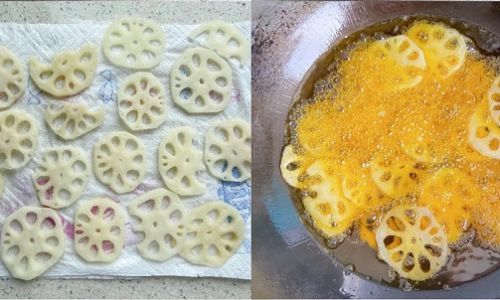Introduction

In the realm of culinary delights, fried lotus root slices (also known as lotus root chips) stand out as a unique and mouthwatering treat. With their golden-brown hue, delicate sweetness, and an unmistakably crispy texture, these snacks are a favorite among food enthusiasts worldwide. However, achieving the perfect balance of crispiness and flavor can be a challenge, even for seasoned chefs. This article aims to demystify the process and provide a comprehensive guide on how to fry lotus root slices to achieve unparalleled crispiness.
Understanding Lotus Root
Before diving into the frying technique, it’s crucial to understand the nature of lotus root. Lotus root, scientifically known as Nelumbo nucifera, is a rhizome that grows underwater. Its cross-sectional slices reveal a series of holes, resembling a wheel or target, which not only add visual appeal but also influence how the slices cook. The flesh of lotus root is firm yet slightly starchy, making it ideal for frying due to its ability to hold shape while absorbing minimal oil.
Selecting the Right Lotus Root
The first step towards crispy fried lotus root slices begins with selecting high-quality ingredients. Look for firm, unblemished roots with smooth, clean skin. Avoid those that are soft, bruised, or have mold spots. Fresh lotus root has a slightly sweet aroma, which is a good indicator of its freshness. If fresh lotus root is unavailable, you can opt for vacuum-packed or canned varieties, but ensure they are free from added preservatives and have been stored properly.
Preparing the Lotus Root Slices
-
Cleaning and Peeling: Begin by thoroughly washing the lotus root under running water to remove any dirt or debris. Use a vegetable peeler to remove the outer layer, which can be tough and slightly bitter.

-
Slicing: Cut the cleaned lotus root into thin, even slices. The thickness of the slices will affect the cooking time and crispiness. Generally, slices between 1/8 to 1/4 inch (3 to 6 mm) thick are ideal. Thinner slices will cook faster and become crispier, but may also burn easily if not monitored closely.
-
Soaking: Soak the sliced lotus root in water for about 30 minutes to remove excess starch. This step is crucial as it helps prevent the slices from becoming gluey during frying. Change the water once or twice during soaking to ensure all starch is removed.
Seasoning and Coating
To elevate the flavor and ensure an even crispier texture, consider seasoning and coating your lotus root slices before frying.
-
Seasoning: Pat the soaked slices dry using paper towels. Lightly sprinkle them with salt, pepper, and any other desired spices such as garlic powder, paprika, or cumin. For a sweet-and-savory twist, you can also add a pinch of sugar or honey.
-
Coating: For an extra layer of crispiness, coat the seasoned slices with a thin layer of cornstarch, rice flour, or a blend of both. This forms a protective barrier that prevents the oil from penetrating too deeply, resulting in lighter and crisper chips. Shake off any excess coating to avoid clumping.
Frying Techniques

The key to achieving crispy lotus root slices lies in the frying process. Here are two methods you can try:
Shallow Frying:
-
Heating the Oil: Pour enough vegetable oil into a heavy-bottomed pan or wok to cover the bottom by about 1/2 inch (1.25 cm). Heat the oil over medium-high heat until it reaches 350°F (175°C). Use a thermometer to ensure accurate temperature control.
-
Frying: Carefully place a few slices of lotus root into the hot oil, ensuring they are not overcrowded. Fry for about 2-3 minutes on each side, or until golden brown and crispy. Use a slotted spoon to flip the slices gently to avoid breaking them.
-
Draining: Remove the fried slices from the oil and place them on a wire rack or paper towels to drain excess oil. This helps maintain their crispiness.
Deep Frying:
-
Heating the Oil: Fill a deep fryer or a large, heavy pot with vegetable oil, ensuring it has enough capacity to fully submerge the lotus root slices. Heat the oil to 375°F (190°C).

-
Frying: Working in batches, carefully lower the seasoned and coated lotus root slices into the hot oil. Fry for about 3-4 minutes, or until they turn golden brown and float to the surface. Use a frying basket or slotted spoon to remove them.
-
Draining and Cooling: Place the fried slices on a wire rack or paper towels to drain and cool slightly before serving.
Serving and Enjoying
Crispy fried lotus root slices can be enjoyed as a standalone snack, paired with dipping sauces like soy sauce, sweet chili sauce, or a blend of garlic and vinegar. They also make a delightful addition to salads, stir-fries, or as a garnish for soups and stews.
Conclusion
Mastering the art of crispy fried lotus root slices requires attention to detail, from selecting the right ingredients to precise temperature control during frying. By following the steps outlined in this guide, you’ll be able to create a delightful, crunchy treat that will delight your taste buds and impress your guests. Remember, practice makes perfect, so don’t be discouraged if your first attempt doesn’t meet your expectations. With each batch, you’ll refine your technique and edge closer to culinary perfection. Happy frying!




0 comments